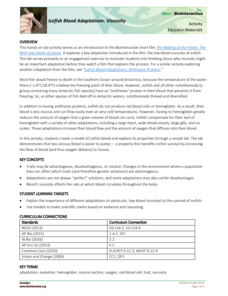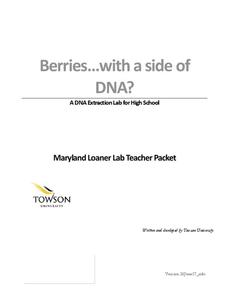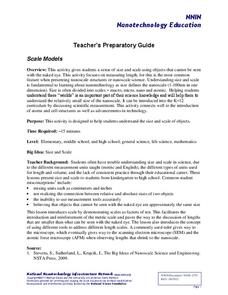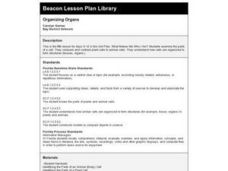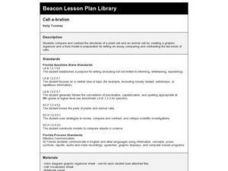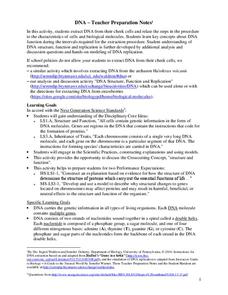Howard Hughes Medical Institute
Icefish Blood Adaptations: Viscosity
Most fish freeze to death when the water is too cold, yet some fish live in the Southern Ocean where the water is often below freezing. Scholars use two models representing the blood from most fish versus the blood from Antarctic fish....
Radford University
Are You Faster than Bacteria?
Just how fast does bacteria grow? Over the course of three lessons, pupils investigate exponential growth with the use of bacteria growth. During the lesson, bacteria from a cell phone is grown to make a connection to real life. Using...
Curated OER
DNA Replication
Students create a model of DNA and simulate replication with their models in an activity that uses licorice, colored marshmallows, and toothpicks. Students also label a diagram of replication and indicate major parts of the DNA molecule.
Cmassengale
Photosynthesis Diagrams Worksheet
Help young botanists get to the root of photosynthesis with this series of worksheets. By completing these diagrams, learners demonstrate their understanding of the biological structures and chemical reactions that make this...
Curated OER
Zebrafish Development
Students examine the early development of zebrafish as a model for embryo development in humans. They observe various stages of zebrafish reproduction from sperm and eggs to fertilized eggs and hatchlings.
Towson University
Berries...With a Side of DNA? (High School)
Is DNA still present after picking fruit or cooking vegetables? Biology scholars extract and collect DNA strands in an impactful lab. Working groups prepare their samples and compare their results to negative and positive standard...
Curated OER
Biology: Make a Model Cell
Students compare and contrast plant and animal cells and then create a model of the latter. They visit Websites to view the cells and answer questions about them. In pairs, students create cell models using plastic baggies, syrup,...
Curated OER
DNA and Protein Synthesis in the Cell
Students explore how DNA fits into chromosomes and how chromosomes relate to the human body. They learn about DNA replication and protein synthesis and model these two processes in Web activities.
Perkins School for the Blind
Chromosome Models- Karyotyping
Create your own karyotypes with clay in a kinesthetic genome activity. This tactile experience was created for visually impaired pupils, but can be used for all hands-on learners who are beginning to study chromosomes. The preparation...
Curated OER
DNA Extraction from Yeast Cells
Students explore DNA. They work in groups and mix prepared detergent/ salt solution, meat tenderizer solution, Fleischman's yeast and water to extract DNA from yeast. Observations are recorded.
National Nanotechnology Infrastructure Network
Scale Models
With instructions to adapt the activities for any grade K-12, any teacher can incorporate the concept of scale into the classroom with a simple, yet effective lesson.
Curated OER
Fighting Infection
Students study immune responses and the structures that are related to immune cells functions. In this fighting infection lesson students construct antibody complexes and model the interaction of the immune system when it is...
Curated OER
The Living Environment
Sixth graders show what they know about plant and animal cells. For this cell project lesson, 6th graders get to choose a project based on their learning style. They can create a visual representation of cells, auditory forms, or build a...
Curated OER
Making Blood!
students research blood's components, and use their math skills to recreate a model of whole blood using commonly found food items.
Curated OER
Organizing Organs
Fifth graders research plant and animals cells and create a Venn Diagram to show the similarities and differences.
Curated OER
Onion Skins
Students explore the structure of a plant cell. They carefully peel a single layer of onion skin from a slice of onion and stain it with methylene blue to observe the structures inside. They use a Digiscope connected to a computer to...
Curated OER
Know Your Telephone
Students describe the parts of a cell phone and role-play a phone call to a customer service representative. They compare/contrast the price of owning and using a cell phone in the U.S. and Venezuela.
Curated OER
How Genes Work Lesson Plan
Students define the key terms that are the structure and function of DNA. In this genetics lesson plan students complete a lab activity in which they construct a model DNA structure.
Curated OER
Levels of Organization
Middle schoolers read and complete a worksheet about the levels of organization of living things from cells to organ systems. They use a text book and the "Cells R Us" worksheet included to create a metaphor for each of the levels. ...
Curated OER
PBS - Scientific American Frontier:Affairs of the Heart:Teaching Guide:Exploring Vessel Physics
Learners explore the relationship between pressure and vessel diameter. They are given an open-ended design challenge in which they engineer their own remote repair device. Students see a model that represents how elevated blood...
Curated OER
Cell-a-bration
Fifth graders study the structures of a plant cell and animal cell. They create a graphic organizer and a food model. Finally, they write an essay comparing and contrasting plant and animal cells.
Curated OER
Cell Division and Differentiation
Tenth graders investigate about mitosis, meiosis, and cell differentiation and their purposes and implications in the development and functioning of multicellular organisms. Students use individual journals and a variety of hands-on...
Curated OER
Schools and Cells
Fourth graders create analogies in poster format between a cell's organelles and their school. For example, 4th graders coul say a cell's mitochondria is like the cafeteria, both are a source of energy.
Curated OER
Extracting DNA from Your Cells - Teacher Preparation Notes
Students extract their own DNA from cheek cells. In this biology instructional activity, students explain the replication process. They identify the structure and composition of DNA.
